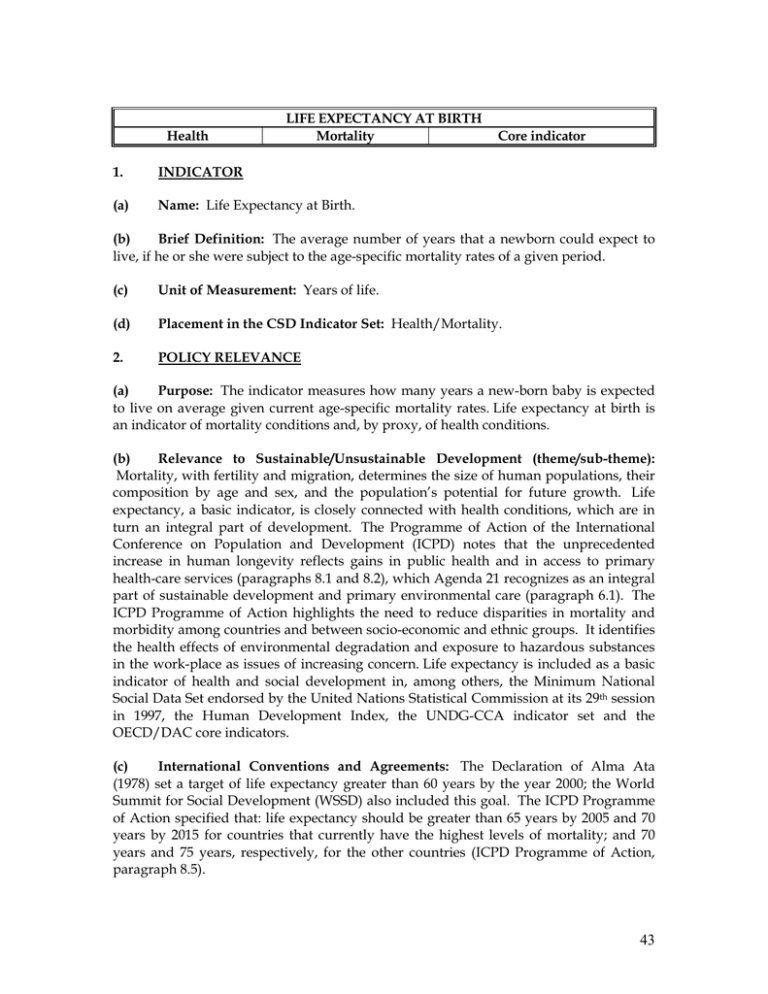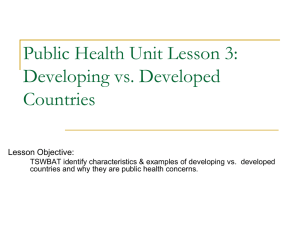LIFE EXPECTANCY AT BIRTH Health Mortality Core indicator 1
advertisement

Health LIFE EXPECTANCY AT BIRTH Mortality 1. INDICATOR (a) Name: Life Expectancy at Birth. Core indicator (b) Brief Definition: The average number of years that a newborn could expect to live, if he or she were subject to the age-specific mortality rates of a given period. (c) Unit of Measurement: Years of life. (d) Placement in the CSD Indicator Set: Health/Mortality. 2. POLICY RELEVANCE (a) Purpose: The indicator measures how many years a new-born baby is expected to live on average given current age-specific mortality rates. Life expectancy at birth is an indicator of mortality conditions and, by proxy, of health conditions. (b) Relevance to Sustainable/Unsustainable Development (theme/sub-theme): Mortality, with fertility and migration, determines the size of human populations, their composition by age and sex, and the population’s potential for future growth. Life expectancy, a basic indicator, is closely connected with health conditions, which are in turn an integral part of development. The Programme of Action of the International Conference on Population and Development (ICPD) notes that the unprecedented increase in human longevity reflects gains in public health and in access to primary health-care services (paragraphs 8.1 and 8.2), which Agenda 21 recognizes as an integral part of sustainable development and primary environmental care (paragraph 6.1). The ICPD Programme of Action highlights the need to reduce disparities in mortality and morbidity among countries and between socio-economic and ethnic groups. It identifies the health effects of environmental degradation and exposure to hazardous substances in the work-place as issues of increasing concern. Life expectancy is included as a basic indicator of health and social development in, among others, the Minimum National Social Data Set endorsed by the United Nations Statistical Commission at its 29th session in 1997, the Human Development Index, the UNDG-CCA indicator set and the OECD/DAC core indicators. (c) International Conventions and Agreements: The Declaration of Alma Ata (1978) set a target of life expectancy greater than 60 years by the year 2000; the World Summit for Social Development (WSSD) also included this goal. The ICPD Programme of Action specified that: life expectancy should be greater than 65 years by 2005 and 70 years by 2015 for countries that currently have the highest levels of mortality; and 70 years and 75 years, respectively, for the other countries (ICPD Programme of Action, paragraph 8.5). 43 (d) International Targets/Recommended Standards: See above. (e) Linkages to Other Indicators: This indicator reflects many social, economic, and environmental influences. It is closely related to other demographic variables and is related to human health and the environment as well as to economic indicators. 3. METHODOLOGICAL DESCRIPTION (a) Underlying Definitions and Concepts: Calculation of life expectancy at birth is based on age-specific mortality rates for a particular calendar period. Mortality rates are commonly tabulated for age groups 0 to1, 1 to 5 years and for five-year age groups thereafter until an open-ended interval starting at age 80 or above. (b) Measurement Methods: Several steps are needed to derive life expectancy from age-specific mortality rates; details on the methodology to follow can be found in demographic or actuarial references that describe the construction of life tables including Pressat (1972) or Shryock and Siegel (1980). For a description of the methodology implemented in computer programs, see United Nations (2003). (c) Limitations of the Indicator: Where data on deaths by age are of good quality, or adjustments for age misstatement and incompleteness can be made, the life expectancy at birth can be calculated directly from registered deaths and population counts, which are usually based on census enumerations. When data on deaths by age are not available because vital registration is deficient, the life expectancy at birth can be estimated using methods that derive indicators of mortality from indirect information on the risks of death obtained from special questions included in censuses or demographic surveys. For information on these indirect methods, see United Nations (1983 and 2003). (d) Status of the Methodology: Well developed and widely employed. (e) Alternative Definitions/ Indicators: Another indicator of general mortality in common use is the Crude Death Rate (CDR), which is the number of deaths in a period (commonly a one-year period) divided by the mid-period population; it is usually expressed in deaths per 1,000 population. The CDR can be calculated from data that have less detail than those needed to calculate the life expectancy at birth, but it has the drawback of being influenced to a substantial degree by age structure of the population. That is, two populations with the same CDR could be subject to markedly different mortality risks at each age. Life expectancy may be calculated separately for males and females, or for both sexes combined. If the underlying data permit, life expectancy may also be calculated for subnational populations. Life expectancy can also be presented for particular ages after birth. For instance, life expectancy at age 60 represents the number of additional years a person aged 60 would expect to live, on average, given current age-specific mortality rates for ages 60 and over. 4. ASSESSMENT OF DATA 44 (a) Data Needed to Compile the Indicator: Age-specific death rates are the basic information for the calculation of the indicator. Some data sources yield estimates of age-specific mortality for only some age groups, so that it may be necessary to employ data from different sources, each adjusted independently, to arrive at a complete and consistent set of rates for a given period. Countries may tabulate data derived from death registration systems at the sub-national level. The under-five mortality rate is more readily available for sub-national populations than life expectancy at birth. (b) National and International Data Availability and Sources: Data on deaths classified by age are compiled by the Statistics Division of the Department of Economic and Social Affairs (DESA) of the United Nations Secretariat on a regular basis but they are reported only by countries with functioning civil registration systems. For all countries, data allowing the estimation of mortality, including those derived from vital registration systems, censuses or demographic surveys are evaluated and, if necessary, adjusted by the Population Division of the Department of Economic and Social Affairs (DESA) as part of the preparation of the United Nations population estimates and projections. (c) Data References: Past, current and projected estimates of life expectancy at birth are prepared for all countries by the Population Division, DESA, and appear in the biennial World Population Prospects reports. 5. AGENCIES INVOLVED IN THE DEVELOPMENT OF THE INDICATOR (a) Lead Agency: The lead agency is the United Nations Department of Economic and Social Affairs (UN/DESA). The contact point is the Director, Population Division, fax no. (1 212) 963 2147. (b) Other Contributing Organizations: United Nations/DESA/Statistics Division; United Nations Children’s Fund (UNICEF); and World Health Organization (WHO). 6. REFERENCES (a) Readings: Pressat, R. (1972). Demographic Analysis: Methods, Results, Applications. London, Edward Arnold; Chicago, Aldine Atherton. Shryock, H. S, and J. S. Siegel (1980). The Methods and Materials of Demography. U.S. Government Printing Office, Washington, D.C. United Nations (1983). Manual X: Indirect Techniques for Demographic Estimation. United Nations Sales No. E.83.XIII.2, New York. ________ (1994). Report of the International Conference on Population and Development. Programme of Action of the International Conference on Population and Development. United Nations Document A/CONF. 171/13. Cairo, Egypt, September 5-13. ________ (2003). MORTPAK for Windows - The United Nations Software Package for Demographic Measurement, CD-ROM (United Nations, New York). 45 ________ (2004). Demographic Yearbook 2001. United Nations publication, Sales No. 03.XIII.1. ________ (2007). World Population Prospects: The 2006 Revision, CD-ROM Edition. (b) Internet site: Statistics and substantive reports are available at: http://www.un.org/esa/population/unpop.htm 46


